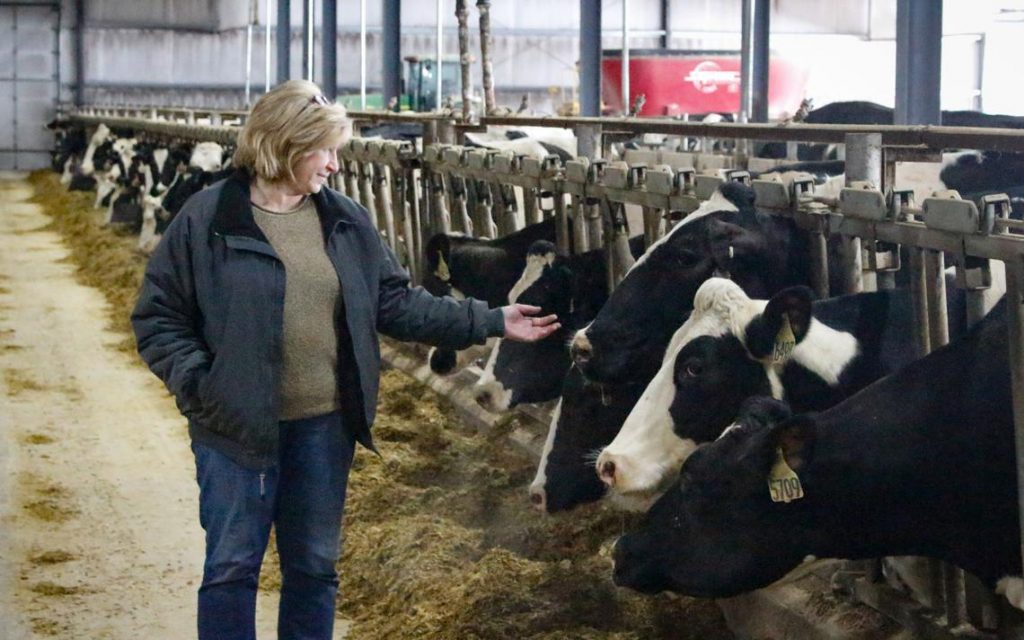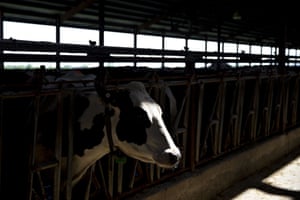The Goodman family has been milking cows in Wisconsin since 1889. Jim Goodman is the last of his line. The 66-year-old farmer has sold his herd and the land where they grazed. His children have chosen other careers.


Collapsing prices, the rise of mega farms in warmer states and fluctuations in demand have led to a spate of bankruptcies
The Goodman family has been milking cows in Wisconsin since 1889. Jim Goodman is the last of his line. The 66-year-old farmer has sold his herd and the land where they grazed. His children have chosen other careers.
“One of our old neighbors used to say that farmers who encourage their children to farm could be charged with child abuse. It’s condemning them to a future where there is no certainty that they could even make a living,” says Goodman, sitting in his old farmstead near the tiny village of Wonewoc in the center of the state.
Wisconsin still styles itself the dairy state. Car number plates come with the slogan “America’s Dairyland”. Last year it was also the state with the highest number of farming bankruptcies – 57, its highest total in a decade. The number of dairy farms across the state has fallen by 49% over the past 15 years.
The decline is fundamentally changing Wisconsin’s rural landscape as schools and small businesses collapse taking the rural communities that supported them with them. Wisconsin is an avatar of a wider problem in the dairy industry. America’s largest milk producer, Dean Foods, filed for bankruptcy last November. Borden, founded in 1857, filed for bankruptcy in January.
The milk industry’s woes have been a long time in the making and no single factor accounts for them. Collapsing prices, the rise of mega farms in warmer states such as Texas and Arizona, the increasingly international trade in dry milk products like whey protein, Trump’s tariffs, the fluctuations in international trade and shifting consumer habits have all played a part.
The irony is that as the number of farms in bankruptcy rises, milk sales and prices are also on the rise. Per-capita dairy consumption reached 646 pounds per person in 2018, the most popular year for dairy in the US since 1962.
America is not drinking as much milk as it once did but the popular narrative that milk alternatives are killing dairy doesn’t hold up. The percentage of milk sales lost to plant “milks” is small compared with other drinks – bottled water in particular – that have already taken a share and milk still outsells plant-based imitators by a margin of more than 11 to 1. And the US is still buying cheese, butter, yogurt, milk powders in infant formula and protein in bars and shakes.
For a state that has defined itself by dairy, the consequences of change are profound.
Goodman was born on the farm. Growing up, local towns would have their own grocery stores, a drugstore, car dealers, machine dealers, says Goodman. “Our little town down the road, had a movie theater, lumber yard. You know, they were all doing well.”
As those farms have gone so have the businesses. School districts don’t have enough children to stay open. “Now you can drive through any small town and if they don’t have a good share of their main street boarded up, they’re doing really well.”
The economics are tough. Milk prices have come back recently to about $17.55 per hundredweight in February 2020, but that is still way down from around $25 in 2014. Prices are expected to rise but in the meantime global forces have battered farmers. Feed prices rose as ethanol production took more crops, China bought more soy and tariffs increased equipment prices. For too many small farmers even as prices recover from a long slump, the cost of producing milk exceeds the prices they can sell it for.
“There was a period in 2013 when China panicked and started to buy every drop of milk on the planet,” says Peter Vitaliano, chief economist at the National Milk Producers Federation. “We had milk prices that dairy farmers would tell their children about.”
The buying spree followed the melamine crisis when Chinese producers had been adulterating milk, baby formula and other foods with melamine, a chemical that is toxic in large quantities, to increase their apparent protein content.
US milk producers started oversupplying milk. Smaller farms like those in Wisconsin produce more of their own feed than the huge players so for a while they were at an advantage. But when China got its milk industry back on track and feed prices came down, the advantage vanished and the collapse started in earnest. “It was particularly brutal on the smaller operations,” says Vitaliano. “That pressure is, unfortunately, likely to continue.”
Goodman made the shift to organic in 2014 and for a while it worked. Organic fits his values; the back of the car outside his home carries an old Occupy “We Are the 99%” sticker and one for Elizabeth Warren. But organic prices collapsed as vast industrial-style dairies in Texas and other warm states with 10,000 or more cows flooded the market with cheap milk. Competing with confinement dairies – “concentrated animal feeding operations” as they are curdlingly known – was impossible.
The huge farms were shipping organic milk from Texas into Wisconsin for a lower price than Goodman was getting paid. “You know, you can’t compete with that,” he says.
As prices collapsed a planned sale fell through. He sold the land and then the cows. “I guess for me, that may have been harder than actually selling land because here you tend to be pretty attached to your cattle.”
Each cow in his 50-strong herd had a name. Lara was his favorite. “When I would come in, she would always just turn around and kind of look at me, looking for someone to scratch her head,” he says. “It seemed like whenever she saw you, she just had to stop and look at you like she sort of was making that connection that you’re OK.”
In Elkhorn, some 130 miles south of Wonewoc, Dave Kyle is hopeful he has found a solution. Kyle, a youthful, trim 60-year-old with hands that look like they could snap a girder, raises brown cows, not the black and white Holsteins that are the most popular breed of dairy cattle in the US. His 150-strong herd produces “A2 milk” that mostly lacks a form of β-casein protein called A1 that proponents argue is easier for people with milk intolerance to digest.
He and his wife Laurie also run Perkup, a cosy cafe in Elkhorn, where you can get an A2 latte – but no nut milks.
Unusually in a rapidly ageing industry Kyle also has an heir. Hayden Kyle, 26, works with his dad and aims to one day take over the farm – in an industry where the average age of a farmer is 58, that is a big advantage.
Hayden Kyle wasn’t interested in farming when he was younger. After college he worked at a department store for a year then told his dad: “I think I want to farm.”
It’s not a popular choice among his peers. “There were 250 kids in my high school class and maybe one other kid is farming,” says Hayden Kyle.
For those less fortunate, life can look bleak. “I know of some farmers that have committed suicide,” says Kyle. “They were third or fourth generation and now the farm ends with them and they feel that terrible burden of, you know, it was on my watch that this fell apart,” he says. “I could see where it gets very overwhelming.”
Farm Aid, the farmers’ support group, started a crisis line during the farming crisis of the 1980s. Goodman says people at Farm Aid have told him the level of calls is now higher than back then. He says farmers should know that the forces ranged against them are beyond their control.
“You can’t just categorically say, well, it was my fault, I did something wrong, because you didn’t. You just happen to get caught up in a system that’s not working.”
• In the US, the suicide prevention lifeline is 1-800-273-8255. In the UK, Samaritans can be contacted on 116 123. In Australia, the crisis support service Lifeline is on 13 11 14. Other international helplines can be found at www.befrienders.org
… we’re asking readers, like you, to make a new year contribution in support of the Guardian’s open, independent journalism. This has been a turbulent decade across the world – protest, populism, mass migration and the escalating climate crisis. The Guardian has been in every corner of the globe, reporting with tenacity, rigour and authority on the most critical events of our lifetimes. At a time when factual information is both scarcer and more essential than ever, we believe that each of us deserves access to accurate reporting with integrity at its heart.
More people than ever before are reading and supporting our journalism, in more than 180 countries around the world. And this is only possible because we made a different choice: to keep our reporting open for all, regardless of where they live or what they can afford to pay.
We have upheld our editorial independence in the face of the disintegration of traditional media – with social platforms giving rise to misinformation, the seemingly unstoppable rise of big tech and independent voices being squashed by commercial ownership. The Guardian’s independence means we can set our own agenda and voice our own opinions. Our journalism is free from commercial and political bias – never influenced by billionaire owners or shareholders. This makes us different. It means we can challenge the powerful without fear and give a voice to those less heard.
None of this would have been attainable without our readers’ generosity – your financial support has meant we can keep investigating, disentangling and interrogating. It has protected our independence, which has never been so critical. We are so grateful.
As we enter a new decade, we need your support so we can keep delivering quality journalism that’s open and independent. And that is here for the long term. Every reader contribution, however big or small, is so valuable.
Legal notice about Intellectual Property in digital contents. All information contained in these pages that is NOT owned by eDairy News and is NOT considered “public domain” by legal regulations, are registered trademarks of their respective owners and recognized by our company as such. The publication on the eDairy News website is made for the purpose of gathering information, respecting the rules contained in the Berne Convention for the Protection of Literary and Artistic Works; in Law 11.723 and other applicable rules. Any claim arising from the information contained in the eDairy News website shall be subject to the jurisdiction of the Ordinary Courts of the First Judicial District of the Province of Córdoba, Argentina, with seat in the City of Córdoba, excluding any other jurisdiction, including the Federal.
1.
2.
3.
4.
5.
eDairy News Spanish
eDairy News PORTUGUESE
